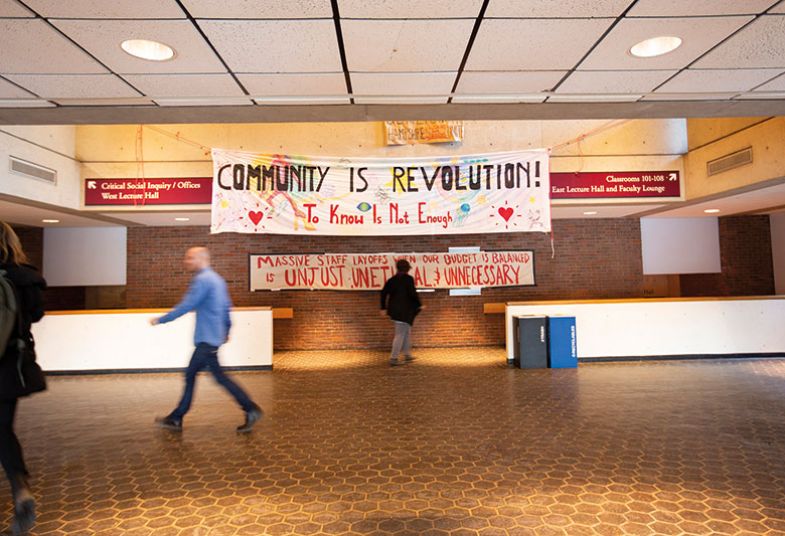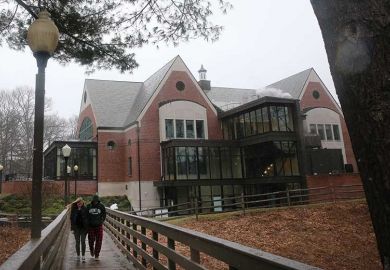The ongoing decline of Hampshire College, a liberal arts institution in Amherst, Massachusetts, is another sad tale of a struggling small private US campus. It may also carry a much larger warning about higher education’s purported future of broad access and lifelong learning.
Hampshire’s signature characteristic is its system of letting students choose their major, or “concentration”, and then working out the combination of classes to make it happen.
This model, whereby students are told to be “the entrepreneur of your own education”, would seem to be prime preparation for a future US economy in which young workers are repeatedly told to expect a dozen or more jobs in their lifetimes and a need to constantly retrain for careers not yet even conceived.
“They are absolutely fearless,” one former Hampshire president, Ralph Hexter, said of its students. “They’ll say, ‘I want to do this’, and maybe they know nothing about it, but they teach themselves.”
“We need to robot-proof our students,” said another former president, Miriam Nelson. “Our educational model – which is enquiry-based, student-driven and very interdisciplinary – is more relevant today, I would say, than even when we were started in 1970.”
And yet, at perhaps the signature location for such an approach, it somehow isn’t working out.
There are various reasons why, many not unique to Hampshire, starting with money. The 1,400-student college has always lacked resources, having been given little financial endowment when created as an experiment by four neighbouring institutions. It also faces the same hurdle of declining high-school enrolment that’s hobbling or closing other small private colleges in the north-eastern US.
But the high level of responsibility Hampshire places on its students to chart their own career – a key demand of the new economy – appears to be exacerbating rather than answering those financial and demographic challenges.
One key reason, said Professor Hexter, now provost at the University of California, Davis, is the growing cost of higher education. Back in the 1970s, he explained, college students often came from families with their own college experience, and the relatively low cost left them far more open to educational risks and the pursuit of personal interests.
Now, with costs exploding and college access expanding – more than 40 per cent of Davis students are first-generation – students and parents are more inclined to stick with safer bets and what they are told are more predictable pay-offs for such a major family investment.
“My parents knew that it was hopeless for them to tell me what I should study, whereas what I observe is a much greater proportion of students today who have parents who are guiding their students much more,” Professor Hexter said.
That appears true even at high-performing institutions.
Reed College in Oregon shares with Hampshire a decidedly countercultural vibe and a top ranking for alumni who later earn doctorates. But Reed is thriving by offering curriculum choices that are long-time liberal arts standards, emphasising mandatory core components.
As US colleges increasingly enrol students with little family experience in higher education, early limits on undergraduate options may prove a key advantage, said Reed’s acting president, Hugh Porter.
“My dad sort of slowed the car down and I got out, and he picked me up four years later,” Mr Porter recalled of his own experience at Yale University. “That is not the case” for many students today, he said. “It’s a big family investment in a different way than it was.”
Money and the wider economy may explain much of why Hampshire can’t do what a place like Reed can. Hiring staff to support students is expensive, and Hampshire was given little seed money by its academic founders a half-century ago. Its current endowment of about $52 million (£40.3 million) is less than a 10th of that of Reed.
The reality is that students don’t necessarily know what to study next, and colleges are struggling with the cost of guiding them through a complex and shifting set of choices. Yet, post-higher education, these same students will enter into a workplace demanding exactly those kinds of abilities and services.
Among other things, said Christina Paxson, president of Brown University, the Hampshire experience should serve as another warning that creating a future generation of Americans constantly retraining themselves for a fast-changing workplace will not come easy.
Rhode Island-based Brown does allow its students to create their own majors; however, only a small minority choose to do so, unlike at Hampshire, where the entire student body does, Professor Paxson said.
And while Hampshire appears to have been built on the assumption that such an open course structure would reduce costs, the reality, Professor Paxson said, is that it is more expensive.
“Giving students a lot of responsibility and freedom in putting together their own curriculum and education requires probably more faculty time rather than less,” she said.
Students “need someone to really help them understand: what is neuroscience, and what can you learn if you study economics, and how do different things fit together”, Professor Paxson said. Guiding them “is resource-intensive. It’s not something that students can do completely on their own.”
Brown, with a $3.8 billion endowment, can manage that, she said. Hampshire, apparently, cannot.
“Hampshire has been a really wonderful experience for many, many students,” Professor Paxson said. “But it’s trying to do something that requires a lot of resources without much in the way of resources.”
Most students, even the high performers, want to be told what to study, said Howard Woolf, director of the Experimental College at Tufts University, which offers small, participation-based and interdisciplinary courses.
“I don’t think people are inherently proactive,” Mr Woolf said. “I think they want to go to a college where they’re going to have structure and be told ‘here’s what you have to do to be successful’.”
As such, the idea that large numbers of US workers will somehow know to stop every few years, and figure out what areas of supplemental education they should acquire for their next job, seems wishful, Mr Porter acknowledged.
“It’s asking too much of workers,” he said.
Professor Paxson agreed. “Workers aren’t going to wake up one day and say, ‘OK, now it’s time for me to learn a new programming language or reinvent my career,’” she said. “People may know they need it, but they may not know exactly what to do to get it.”
The solution for the broader US workforce, Professor Paxson said, is likely going to require a lot more coordination between the corporate world and higher education than has been seen so far.
Another possible result, Mr Porter said, was that Americans might realise the need to fund their education system better.
“There’s some point at which paying people to be teachers is something we might need to do,” he said.

For its part, Hampshire is focused at the moment on looking inward. Professor Nelson resigned as president earlier this month, after facing pushback to her idea of seeking a partner with which the college could merge. She and others have suggested that Hampshire by itself simply isn’t big enough to cope with the inevitable loss of students who can’t handle a design-your-major model and a free-flowing course environment.
Professor Hexter did try during his tenure a decade ago to expand Hampshire by creating a master’s programme. But he faced pushback from faculty, who were fearful of diluting what is in essence a master’s-type approach at the undergraduate level. He and Professor Nelson also agreed that Hampshire wasn’t proactive enough over the years in publicising its unique mission.
Hampshire may also just be an idea whose time has passed, given that short-term job training is taking precedence in higher education over any ideals of long-term human growth. The 1960s and 1970s produced at least a few dozen such experimental institutions, Mr Woolf said. The surviving models, such as his own Experimental College at Tufts, are just portions of larger institutions.
“They’re basically all gone,” he said. “They either got reabsorbed or they died.”
The shift reflects a broader sense of pessimism hanging over higher education, Mr Porter said.
“It was started, in some ways, at the tail end of the heyday of funding for higher education,” he said of Hampshire. “In a way, it’s symbolic of a kind of optimism about higher education.”
Still, he said, the suddenness of the situation – with shifts that include Professor Nelson’s resignation, Hampshire’s accreditation coming under question, and the possibility of Hampshire not even accepting an incoming class for the next academic year – has been “frightening to people”, Mr Porter said.
“They hadn’t heard that anything was really wrong,” he said, “and then all of a sudden this prominent place seems to be evaporating.”
paul.basken@timeshighereducation.com
Academics and university leaders will discuss how universities can encourage innovative teaching and learning practices at Times Higher Education’s Teaching Excellence Summit, which is taking place at Western University, in London, Ontario, Canada, from 4-6 June.
POSTSCRIPT:
Print headline: Experimental colleges: outdated model or future-proofing students?
Register to continue
Why register?
- Registration is free and only takes a moment
- Once registered, you can read 3 articles a month
- Sign up for our newsletter
Subscribe
Or subscribe for unlimited access to:
- Unlimited access to news, views, insights & reviews
- Digital editions
- Digital access to THE’s university and college rankings analysis
Already registered or a current subscriber?








